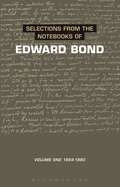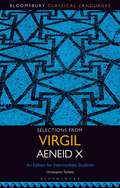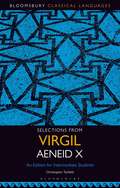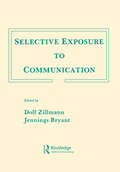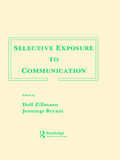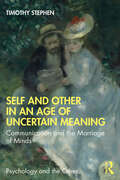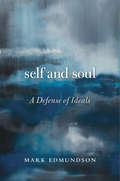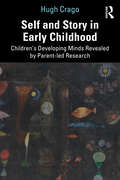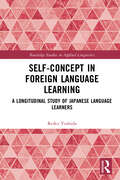- Table View
- List View
Selections from the Notebooks Of Edward Bond: Volume One 1959-1980 (Diaries, Letters and Essays #1)
by Edward BondIn this first volume of notebooks, Edward Bond reveals himself to be one of the finest and most creative minds to have emerged in the twentieth century. Exploring the meeting point between politics and the art of the writer, Bond's notes chart the creative progress of his work and thinking over a twenty-year period, from 1959, when his first plays started to be produced at London's Royal Court Theatre, to 1979, when he had achieved fame as a major writer. While providing a detailed commentary on his plays the Notebooks also contain early play drafts, poems and stories, his thoughts on life, Brecht, art and dramatic method as well as his notes on censorship.
Selections from Virgil Aeneid VIII: An Edition for Intermediate Students (Bloomsbury Classical Languages)
by Keith MaclennanThis is the first intermediate-student edition of a selection from Virgil's Aeneid VIII. Lines 86–279 and 558–584 are included as Latin text with an accompanying commentary and vocabulary. Focusing on a deliberately concise extract from the original, this edition is designed to be manageable for students reading the text for the first time while also perfectly encapsulating the interest of the longer work and inspiring further study of it. A detailed introduction explains points of historical and stylistic interest.Book VIII of the Aeneid is remarkable for the diversity of its subject matter. Aeneas travels upriver to the site where Rome will be founded. He meets King Evander, who tells him the dramatic story of Hercules and Cacus and shows him round 'Rome' before it is Rome. Aeneas' mother makes new armour for him and at the end of the book we see him brandishing the shield whose centrepiece is the triumph of Augustus. The selection presented here focuses on Evander and Hercules, and concludes with the fatal moment when Aeneas takes Evander's son Pallas to war. Its vivid narrative, human characters and larger-than-life heroes and villains are compelling reading.
Selections from Virgil Aeneid VIII: An Edition for Intermediate Students (Bloomsbury Classical Languages)
by Keith MaclennanThis is the first intermediate-student edition of a selection from Virgil's Aeneid VIII. Lines 86–279 and 558–584 are included as Latin text with an accompanying commentary and vocabulary. Focusing on a deliberately concise extract from the original, this edition is designed to be manageable for students reading the text for the first time while also perfectly encapsulating the interest of the longer work and inspiring further study of it. A detailed introduction explains points of historical and stylistic interest.Book VIII of the Aeneid is remarkable for the diversity of its subject matter. Aeneas travels upriver to the site where Rome will be founded. He meets King Evander, who tells him the dramatic story of Hercules and Cacus and shows him round 'Rome' before it is Rome. Aeneas' mother makes new armour for him and at the end of the book we see him brandishing the shield whose centrepiece is the triumph of Augustus. The selection presented here focuses on Evander and Hercules, and concludes with the fatal moment when Aeneas takes Evander's son Pallas to war. Its vivid narrative, human characters and larger-than-life heroes and villains are compelling reading.
Selections from Virgil Aeneid X: An Edition for Intermediate Students (Bloomsbury Classical Languages)
by Christopher TanfieldThis is the first intermediate-student edition of a selection from Virgil's Aeneid X. Lines 215–250, 260–307, 362–398 and 426–542 are included as Latin text with an accompanying commentary and vocabulary. Focusing on a deliberately concise extract from the original, this edition is designed to be manageable for students reading the text for the first time while also perfectly encapsulating the interest of the longer work and inspiring further study of it. A detailed introduction explains points of historical and stylistic interest, encompassing the whole of Book X, including sections omitted here from the Latin.In Book X, the story moves from a council of the gods, via a depiction of Aeneas's return by sea to his beleaguered Trojan camp, to a bloody field of battle. We see Aeneas for the first time as a heroic warrior, but also afflicted by the searing pain of loss as the young son of his new ally, entrusted to him by his father, is killed. Aeneas is for now cheated of his revenge, a revenge which is the preoccupation of the rest of the poem. He does, however, slay the son of a champion of the opposition and then the champion himself, in scenes which re-emphasise that pain.The heart of the book, where Aeneas and his allies join the fray, constitutes the selection presented here. It is an immensely powerful confrontation between violence and compassion, cruelty and nobility.
Selections from Virgil Aeneid X: An Edition for Intermediate Students (Bloomsbury Classical Languages)
by Christopher TanfieldThis is the first intermediate-student edition of a selection from Virgil's Aeneid X. Lines 215–250, 260–307, 362–398 and 426–542 are included as Latin text with an accompanying commentary and vocabulary. Focusing on a deliberately concise extract from the original, this edition is designed to be manageable for students reading the text for the first time while also perfectly encapsulating the interest of the longer work and inspiring further study of it. A detailed introduction explains points of historical and stylistic interest, encompassing the whole of Book X, including sections omitted here from the Latin.In Book X, the story moves from a council of the gods, via a depiction of Aeneas's return by sea to his beleaguered Trojan camp, to a bloody field of battle. We see Aeneas for the first time as a heroic warrior, but also afflicted by the searing pain of loss as the young son of his new ally, entrusted to him by his father, is killed. Aeneas is for now cheated of his revenge, a revenge which is the preoccupation of the rest of the poem. He does, however, slay the son of a champion of the opposition and then the champion himself, in scenes which re-emphasise that pain.The heart of the book, where Aeneas and his allies join the fray, constitutes the selection presented here. It is an immensely powerful confrontation between violence and compassion, cruelty and nobility.
Selections from Virgil Aeneid XI: An Edition for Intermediate Students (Bloomsbury Classical Languages)
by Ashley CarterThis is the first intermediate-student edition of a selection from Virgil's Aeneid XI. Lines 1–224, 498–521, 532–596, 648–689 and 725–835 are included as Latin text with an accompanying commentary and vocabulary. Focusing on a deliberately concise extract from the original, this edition is designed to be manageable for students reading the text for the first time while also perfectly encapsulating the interest of the longer work and inspiring further study of it. A detailed introduction explains points of historical and stylistic interest, encompassing the whole of Book XI, including sections omitted here from the Latin.In Book XI Pallas, the warrior son of Evander who was killed by Turnus, is buried, amid the mourning of his father and the Trojans. After a truce to collect and bury the dead on both sides, fighting resumes, during which the warrior-maiden Camilla battles bravely for the Latins before being killed. The events of the book take up just four days: Pallas' funeral occupies the first; the second and third are devoted (briefly) to the truce and burials; the fourth, taking up the second half of the book, is concerned with Camilla's aristeia, in which she is likened to an Amazon.
Selections from Virgil Aeneid XI: An Edition for Intermediate Students (Bloomsbury Classical Languages)
by Ashley CarterThis is the first intermediate-student edition of a selection from Virgil's Aeneid XI. Lines 1–224, 498–521, 532–596, 648–689 and 725–835 are included as Latin text with an accompanying commentary and vocabulary. Focusing on a deliberately concise extract from the original, this edition is designed to be manageable for students reading the text for the first time while also perfectly encapsulating the interest of the longer work and inspiring further study of it. A detailed introduction explains points of historical and stylistic interest, encompassing the whole of Book XI, including sections omitted here from the Latin.In Book XI Pallas, the warrior son of Evander who was killed by Turnus, is buried, amid the mourning of his father and the Trojans. After a truce to collect and bury the dead on both sides, fighting resumes, during which the warrior-maiden Camilla battles bravely for the Latins before being killed. The events of the book take up just four days: Pallas' funeral occupies the first; the second and third are devoted (briefly) to the truce and burials; the fourth, taking up the second half of the book, is concerned with Camilla's aristeia, in which she is likened to an Amazon.
Selections from Virgil's Aeneid Books 7-12: A Student Reader
by Ashley CarterThis reader of Virgil's text features passages from the second half of the Aeneid and is designed to help students understand and appreciate Virgil's poem, as well as improve their Latin reading skills. Each Latin passage is accompanied by running vocabulary, on-page commentary notes and targeted questions. The book can be used as a source of one-off unseen passages or as a reader for students working through individual books or the whole poem. The commentary notes explain references to characters, places and events, provide linguistic and grammatical help on more challenging Latin phrases, and point out stylistic features. The questions test students' comprehension of the characters and storyline, and give them practice in handling literary terms. The passages are linked by summaries of the continuing plot, so students can grasp the progression of the poem as a whole. An introduction sets the story of the Aeneid in its mythological, literary and historical context and includes a glossary of literary devices and essays explaining the principles of Virgil's word order and metre. At the end of the book is a complete alphabetical vocabulary list.
Selections from Virgil's Aeneid Books 7-12: A Student Reader
by Ashley CarterThis reader of Virgil's text features passages from the second half of the Aeneid and is designed to help students understand and appreciate Virgil's poem, as well as improve their Latin reading skills. Each Latin passage is accompanied by running vocabulary, on-page commentary notes and targeted questions. The book can be used as a source of one-off unseen passages or as a reader for students working through individual books or the whole poem. The commentary notes explain references to characters, places and events, provide linguistic and grammatical help on more challenging Latin phrases, and point out stylistic features. The questions test students' comprehension of the characters and storyline, and give them practice in handling literary terms. The passages are linked by summaries of the continuing plot, so students can grasp the progression of the poem as a whole. An introduction sets the story of the Aeneid in its mythological, literary and historical context and includes a glossary of literary devices and essays explaining the principles of Virgil's word order and metre. At the end of the book is a complete alphabetical vocabulary list.
Selective Exposure To Communication (Routledge Communication Series)
by Dolf Zillmann and Jennings BryantFirst published in 1985. Routledge is an imprint of Taylor & Francis, an informa company.
Selective Exposure To Communication (Routledge Communication Series)
by Dolf Zillmann Jennings BryantFirst published in 1985. Routledge is an imprint of Taylor & Francis, an informa company.
Selena by Mary Tighe: A Scholarly Edition
by Harriet Kramer LinkinMary Tighe's unpublished novel Selena is one of the great unknown treasures of British Romanticism. Completed in 1803, this brilliant, compulsively readable, beautifully written, and psychologically astute courtship novel is finally available in a scholarly edition that reveals Mary Tighe to have been as talented a fiction writer as she was a poet. The history of this amazing work's long journey from manuscript to print is only one of the stories Harriet Kramer Linkin recounts in this scrupulously annotated edition based on the only known copy of the manuscript, currently part of the National Library of Ireland's holdings. Linkin's introduction situates the novel in its historical context, draws attention to significant aspects of the plots and characters, and makes a strong case for Selena's importance for understanding the history of the novel, fiction by women, Anglo-Irish fiction, silver-fork novels, and the Romantic period. Explanatory notes explain obscure references and contexts, identify allusions to other writers, and provide translations of any non-English or archaic words. Selena itself is a revelation in its frank treatment of the darker aspects of Tighe's world, including parents who mistreat, cheat, or fail their children and spouses who commit adultery or betray one another emotionally. At the same time, it is magnificent in its stunning and moving portrayals of romantic love, of the possibility and importance of female friendship, of the difficult necessity of choosing sense over sensibility, and of the need for women and men to choose self-enhancing vocations. This extraordinary novel is destined to open up new ways of thinking by scholars of the Romantic era and the history of the novel.
Selena by Mary Tighe: A Scholarly Edition
by Harriet Kramer LinkinMary Tighe's unpublished novel Selena is one of the great unknown treasures of British Romanticism. Completed in 1803, this brilliant, compulsively readable, beautifully written, and psychologically astute courtship novel is finally available in a scholarly edition that reveals Mary Tighe to have been as talented a fiction writer as she was a poet. The history of this amazing work's long journey from manuscript to print is only one of the stories Harriet Kramer Linkin recounts in this scrupulously annotated edition based on the only known copy of the manuscript, currently part of the National Library of Ireland's holdings. Linkin's introduction situates the novel in its historical context, draws attention to significant aspects of the plots and characters, and makes a strong case for Selena's importance for understanding the history of the novel, fiction by women, Anglo-Irish fiction, silver-fork novels, and the Romantic period. Explanatory notes explain obscure references and contexts, identify allusions to other writers, and provide translations of any non-English or archaic words. Selena itself is a revelation in its frank treatment of the darker aspects of Tighe's world, including parents who mistreat, cheat, or fail their children and spouses who commit adultery or betray one another emotionally. At the same time, it is magnificent in its stunning and moving portrayals of romantic love, of the possibility and importance of female friendship, of the difficult necessity of choosing sense over sensibility, and of the need for women and men to choose self-enhancing vocations. This extraordinary novel is destined to open up new ways of thinking by scholars of the Romantic era and the history of the novel.
The Self and It: Novel Objects in Eighteenth-Century England
by Julie ParkObjects we traditionally regard as "mere" imitations of the human—dolls, automata, puppets—proliferated in eighteenth-century England's rapidly expanding market culture. During the same period, there arose a literary genre called "the novel" that turned the experience of life into a narrated object of psychological plausibility. Park makes a bold intervention in histories of the rise of the novel by arguing that the material objects abounding in eighteenth-century England's consumer markets worked in conjunction with the novel, itself a commodity fetish, as vital tools for fashioning the modern self. As it constructs a history for the psychology of objects, The Self and It revises a story that others have viewed as originating later: in an age of Enlightenment, things have the power to move, affect people's lives, and most of all, enable a fictional genre of selfhood. The book demonstrates just how much the modern psyche—and its thrilling projections of "artificial life"—derive from the formation of the early novel, and the reciprocal activity between made things and invented identities that underlie it.
The Self and Its Pleasures: Bataille, Lacan, and the History of the Decentered Subject
by Carolyn J. DeanWhy did France spawn the radical poststructuralist rejection of the humanist concept of ‘man’ as a rational, knowing subject? In this innovative cultural history, Carolyn J. Dean sheds light on the origins of poststructuralist thought, paying particular attention to the reinterpretation of the self by Jacques Lacan, Georges Bataille, and other French thinkers. Arguing that the widely shared belief that the boundaries between self and other had disappeared during the Great War helps explain the genesis of the new concept of the self, Dean examines an array of evidence from medical texts and literary works alike. The Self and Its Pleasures offers a pathbreaking understanding of the boundaries between theory and history.
Self and Other in an Age of Uncertain Meaning: Communication and the Marriage of Minds (Psychology and the Other)
by Timothy StephenSelf and Other in an Age of Uncertain Meaning explores the nature and origins of widespread problems of self in modern societies. It examines the paradoxical interplay between the modern world's many benefits and freedoms, and its mounting social challenges and psycho-emotional impacts. Over time the character of consciousness has shifted in concert with societal trends. The experienced world has become more nuanced, fragmented, and uncertain, as well as increasingly personal and intimate, reshaping social relationships. Chapters analyze the interdependence of language, mind, intimacy, the self, and culture, arguing that as the coevolution of these five factors produced the modern world, many features of contemporary culture have become disruptive to security of being. The book explores the importance to the vital sense of self in constructing relationships based in mutual recognition of moral and intellectual equality between partners.Rich with examples from everyday experience, this text offers profound insights for those interested in sociology, psychoanalysis, psychology, communication, history, and culture.
Self and Other in an Age of Uncertain Meaning: Communication and the Marriage of Minds (Psychology and the Other)
by Timothy StephenSelf and Other in an Age of Uncertain Meaning explores the nature and origins of widespread problems of self in modern societies. It examines the paradoxical interplay between the modern world's many benefits and freedoms, and its mounting social challenges and psycho-emotional impacts. Over time the character of consciousness has shifted in concert with societal trends. The experienced world has become more nuanced, fragmented, and uncertain, as well as increasingly personal and intimate, reshaping social relationships. Chapters analyze the interdependence of language, mind, intimacy, the self, and culture, arguing that as the coevolution of these five factors produced the modern world, many features of contemporary culture have become disruptive to security of being. The book explores the importance to the vital sense of self in constructing relationships based in mutual recognition of moral and intellectual equality between partners.Rich with examples from everyday experience, this text offers profound insights for those interested in sociology, psychoanalysis, psychology, communication, history, and culture.
Self and Soul: A Defense of Ideals
by Mark EdmundsonAn ARTery Best Book of the Year An Art of Manliness Best Book of the Year In a culture that has become progressively more skeptical and materialistic, the desires of the individual self stand supreme, Mark Edmundson says. We spare little thought for the great ideals that once gave life meaning and worth. Self and Soul is an impassioned effort to defend the values of the Soul. “An impassioned critique of Western society, a relentless assault on contemporary complacency, shallowness, competitiveness and self-regard…Throughout Self and Soul, Edmundson writes with a Thoreau-like incisiveness and fervor…[A] powerful, heartfelt book.” —Michael Dirda, Washington Post “[Edmundson’s] bold and ambitious new book is partly a demonstration of what a ‘real education’ in the humanities, inspired by the goal of ‘human transformation’ and devoted to taking writers seriously, might look like…[It] quietly sets out to challenge many educational pieties, most of the assumptions of recent literary studies—and his own chosen lifestyle.” —Mathew Reisz, Times Higher Education “Edmundson delivers a welcome championing of humanistic ways of thinking and living.” —Kirkus Reviews
Self and Soul: A Defense of Ideals
by Mark EdmundsonAn ARTery Best Book of the Year An Art of Manliness Best Book of the Year In a culture that has become progressively more skeptical and materialistic, the desires of the individual self stand supreme, Mark Edmundson says. We spare little thought for the great ideals that once gave life meaning and worth. Self and Soul is an impassioned effort to defend the values of the Soul. “An impassioned critique of Western society, a relentless assault on contemporary complacency, shallowness, competitiveness and self-regard…Throughout Self and Soul, Edmundson writes with a Thoreau-like incisiveness and fervor…[A] powerful, heartfelt book.” —Michael Dirda, Washington Post “[Edmundson’s] bold and ambitious new book is partly a demonstration of what a ‘real education’ in the humanities, inspired by the goal of ‘human transformation’ and devoted to taking writers seriously, might look like…[It] quietly sets out to challenge many educational pieties, most of the assumptions of recent literary studies—and his own chosen lifestyle.” —Mathew Reisz, Times Higher Education “Edmundson delivers a welcome championing of humanistic ways of thinking and living.” —Kirkus Reviews
Self and Story in Early Childhood: Children’s Developing Minds Revealed by Parent-led Research
by Hugh CragoOur children grow up into a world of stories—in books, on screens—but what do they make of the stories we offer them? What do they think and feel as they listen to a parent read a picture-book? What if a story confuses or upsets them? Over the past fifty years, several intelligent, committed mothers undertook the onerous task of recording exactly what their children said and did in response to the stories they shared. Some of their records extended over five years, or even longer. Their research, done without funding or academic supervision, offers us unparalleled insight into children’s minds long before they learn to speak—let alone learn to read. In Self and Story in Early Childhood, Hugh Crago draws on his unusual combination of expertise in literary studies, developmental psychology and psychotherapy to re-examine the startling implications of this neglected body of evidence. He highlights how much children can achieve without formal teaching, but with the supportive presence of a trusted adult who will participate with them in the story experience. This book will be of great interest to scholars of developmental psychology, early literacy and narratology, as well as to professionals working with preschoolers. Most of all, it will fascinate parents who themselves share stories with their child.
Self and Story in Early Childhood: Children’s Developing Minds Revealed by Parent-led Research
by Hugh CragoOur children grow up into a world of stories—in books, on screens—but what do they make of the stories we offer them? What do they think and feel as they listen to a parent read a picture-book? What if a story confuses or upsets them? Over the past fifty years, several intelligent, committed mothers undertook the onerous task of recording exactly what their children said and did in response to the stories they shared. Some of their records extended over five years, or even longer. Their research, done without funding or academic supervision, offers us unparalleled insight into children’s minds long before they learn to speak—let alone learn to read. In Self and Story in Early Childhood, Hugh Crago draws on his unusual combination of expertise in literary studies, developmental psychology and psychotherapy to re-examine the startling implications of this neglected body of evidence. He highlights how much children can achieve without formal teaching, but with the supportive presence of a trusted adult who will participate with them in the story experience. This book will be of great interest to scholars of developmental psychology, early literacy and narratology, as well as to professionals working with preschoolers. Most of all, it will fascinate parents who themselves share stories with their child.
Self-Care, Translation Professionalization, and the Translator’s Ethical Agency: Ethics of Epimeleia Heautou (ISSN)
by Abderrahman BoukhaffaThis book draws on an interdisciplinary approach to investigate the impact of codes of ethics as prescribed in translator organizations, proposing alternative ethical pathways grounded in self-care ethics to enhance translators’ symbolic recognition and ethical agency.The volume seeks to provide a counterpoint to existing views in translation studies research on ethics by building on work in sociology and philosophical genealogy, particularly Foucault’s notion of Epimeleia Heautou, to establish a framework of self-care ethics. Featuring analyses of various codes of ethics across different professional associations, the book offers a critical examination of the potential impact of codified ethics on translator autonomy and symbolic status and in turn, their broader social and planetary responsibilities within their roles as translators beyond the translation community. In setting out an alternative charter of ethics which promotes a culture of the self within larger institutions and critical pedagogy within translator education programs, the volume charts new directions in emergent debates on ethics in translation practice.This book will appeal to scholars in translation and interpreting studies, particularly those interested in ethics and sociological and philosophical approaches within the discipline.
Self-Care, Translation Professionalization, and the Translator’s Ethical Agency: Ethics of Epimeleia Heautou (ISSN)
by Abderrahman BoukhaffaThis book draws on an interdisciplinary approach to investigate the impact of codes of ethics as prescribed in translator organizations, proposing alternative ethical pathways grounded in self-care ethics to enhance translators’ symbolic recognition and ethical agency.The volume seeks to provide a counterpoint to existing views in translation studies research on ethics by building on work in sociology and philosophical genealogy, particularly Foucault’s notion of Epimeleia Heautou, to establish a framework of self-care ethics. Featuring analyses of various codes of ethics across different professional associations, the book offers a critical examination of the potential impact of codified ethics on translator autonomy and symbolic status and in turn, their broader social and planetary responsibilities within their roles as translators beyond the translation community. In setting out an alternative charter of ethics which promotes a culture of the self within larger institutions and critical pedagogy within translator education programs, the volume charts new directions in emergent debates on ethics in translation practice.This book will appeal to scholars in translation and interpreting studies, particularly those interested in ethics and sociological and philosophical approaches within the discipline.
Self-Concept in Foreign Language Learning: A Longitudinal Study of Japanese Language Learners (Routledge Studies in Applied Linguistics)
by Reiko YoshidaThis book explores self-concept in foreign language (FL) learning, tracing the trajectories of a group of Japanese language learners at an Australian university to illuminate new insights about the factors impacting positive self-concept and implications for language learning more broadly.The volume calls attention to the ways in which learners’ perception of themselves as FL learners plays a fundamental role in FL learning. Drawing on data from a longitudinal study, including student diaries, interviews and classroom observations, Yoshida outlines shifts in self-concept as learners progress from secondary school to university courses to study abroad and beyond. The book demonstrates how the learner journey is marked by a growing recognition of the importance of practice for achievement but also a greater sense of self-consciousness, with learners’ agency in creating opportunities for themselves to practice their FL as a key factor in improving self-concept over time. This work offers unique observations about self-concept for learners who already ‘have’ global English as a first language, inspiring ways forward for future research and language teaching in other under-studied languages. The book will appeal to students and researchers in applied linguistics, SLA and foreign language learning, as well as stakeholders in Japanese language programs.
Self-Concept in Foreign Language Learning: A Longitudinal Study of Japanese Language Learners (Routledge Studies in Applied Linguistics)
by Reiko YoshidaThis book explores self-concept in foreign language (FL) learning, tracing the trajectories of a group of Japanese language learners at an Australian university to illuminate new insights about the factors impacting positive self-concept and implications for language learning more broadly.The volume calls attention to the ways in which learners’ perception of themselves as FL learners plays a fundamental role in FL learning. Drawing on data from a longitudinal study, including student diaries, interviews and classroom observations, Yoshida outlines shifts in self-concept as learners progress from secondary school to university courses to study abroad and beyond. The book demonstrates how the learner journey is marked by a growing recognition of the importance of practice for achievement but also a greater sense of self-consciousness, with learners’ agency in creating opportunities for themselves to practice their FL as a key factor in improving self-concept over time. This work offers unique observations about self-concept for learners who already ‘have’ global English as a first language, inspiring ways forward for future research and language teaching in other under-studied languages. The book will appeal to students and researchers in applied linguistics, SLA and foreign language learning, as well as stakeholders in Japanese language programs.
